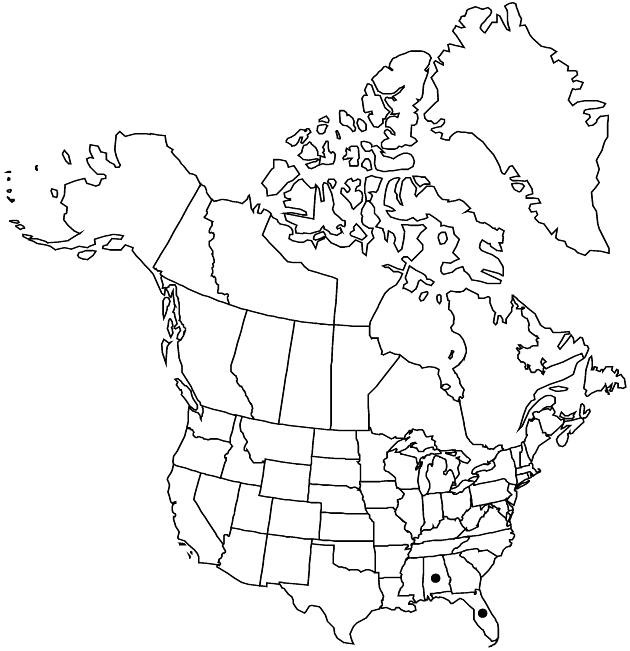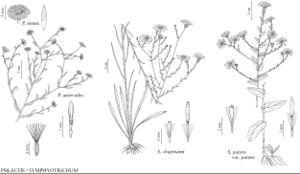Symphyotrichum chapmanii
in J. C. Semple et al., Cult. Native Asters Ontario, 133. 2002.
Perennials, 30–80 cm, cespitose; rhizomes stout. Stems 1–3+, erect (sometimes brown proximally, strict to straight), glabrous. Leaves green to dark green, firm, ± fleshy, margins entire, ciliate, apices acute, callous, faces sparsely strigillose; basal persistent or petiole bases marcescent, long-petiolate (to 15 cm; petioles sheathing, margins glabrous), blades linear to linear-lanceolate, 10–30 × 2–7 mm, bases cuneate to subattenuate, margins sparsely denticulate or entire, indurate-translucent; proximal cauline persistent, sessile or subpetiolate, blades linear, 42–105 × 1–3 mm, bases clasping, margins often revolute; distal sessile, blades usually linear, sometimes awl-shaped, 50–180 × 5–10 mm, strongly reduced distally, more abruptly so on array branches, bases subclasping to adnate for 1/2+ length, margins often revolute. Heads in open, usually corymbiform, sometimes ± paniculiform arrays, branches ascending, simple, slender, elongate. Peduncles 1–20+ cm, slender, glabrous, bracts 4–22, linear (awl-shaped), grading into phyllaries. Involucres cylindro-campanulate, 5.5–9 mm. Phyllaries in 4–5 (–6) series, oblong-lanceolate (outer) to linear-lanceolate (innermost), bases indurate (at least inner), margins scarious, hyaline, purplish distally, ciliolate, green zones narrowly lanceolate, not evident, apices purplish, acute (outer) to acuminate (inner), sometimes mucronate (inner), faces sparsely villous. Ray-florets 8–23; corollas purple to blue-lavender, laminae (10–) 14–15 (–20) × 0.8–2.2 mm. Disc-florets 47–57; corollas pale-yellow, 4.7–6.3 mm, throats funnelform to narrowly campanulate, lobes triangular, 0.5–0.7 mm (proximally sparsely pilose). Cypselae tan to gray-brown (nerves stramineous), obovoid, compressed, 3.1–4.5 mm, 8–10 (–14) -nerved, faces glabrous; pappi yellowish, 4.4–4.7 mm. 2n = 14.
Phenology: Flowering Sep–Nov(–Dec).
Habitat: Wet savannas, pine flatwoods, bogs, and acid swamps
Elevation: 0–30 m
Distribution

Ala., Fla.
Discussion
Of conservation concern.
Symphyotrichum chapmanii is known from the Appalachicola Valley, northern Florida and adjacent southeast Alabama (where it is possibly extirpated), and is disjunct to St. Lucie County (Florida).
Selected References
None.
Lower Taxa
"adnate" is not a number.
